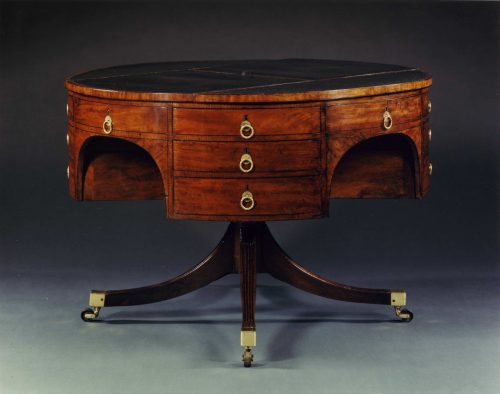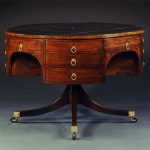9129 AN UNUSAL MAHOGANY AND EBONY INLAID DRUM TABLE English. Circa 1800. Measurements: Height: 32 1/4″ (82cm) Diameter: 47 3/4″ (121.5cm)

Research
Of mahogany with ebony line inlay. The circular top with tooled leather inset set with two ratchetted leaves, the four kneeholes below single drawers, interspersed with sets of three drawers, each drawer with later foliated ring handles, the whole raised on a baluster stem with four downswept fluted legs, each with plain brass capping and castors.
Circular tables raised on a pedestal and set with a leather top first evolved as pieces of library furniture in the second half of the 18th century, when they were soon adopted by the most eminent furniture-makers of the day. Such pieces, which later acquired the name ‘drum tables,’ appear to have been a development from the rent table, a peculiarly English mid-18th-century form used in the estate offices of grand country houses.1 The rent table differed from the form of the drum table in having a square paneled base, but posed the same test of the skill and ingenuity of the craftsman who had to overcome the technical difficulties inherent in placing curved drawers in the circular frieze of the table.
Unlike the form of a typical drum table, which has a single set of drawers around the frieze, the present table has the unusual added feature of four kneeholes interspersed with sets of three drawers. Two ratchetted leaves on the table’s leather surface can be raised and lowered for reading. The stylish simplicity of the table’s curving outswept legs, derived from the example of the Klismos chairs of ancient Greece, reveals the influence of antiquity on the fashion of the period,2 however, the overall ornamentation and treatment of the brass mounts is highly restrained.
Footnotes:
1. Claxton Stevens, Christopher and Stewart Whittington. 18th Century English Furniture: The Norman Adams Collection. Woodbridge, 1983. 110-111.
2. Morley, John. Furniture: The Western Tradition. London, 1999. 207.

Comments are closed.